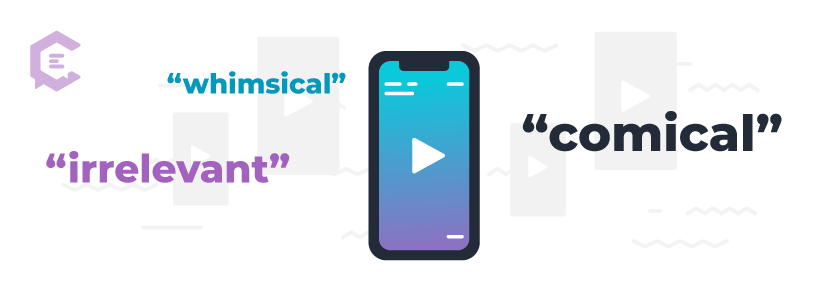If you’ve ever been asked by executives about “the next big thing” on social media (and if you haven’t, are you really a social media marketer?), a simple glance at the list of the top downloaded apps will show you that if you haven’t yet considered TikTok, now is the time to start thinking.
However, considering using TikTok for brands and actually deciding to develop content are two separate things. Just because a social media platform is making waves among audiences doesn’t necessarily mean it is a place for your brand or organization — especially TikTok.
Before jumping into TikTok, you need to consider the potential pros and cons of this controversial platform to determine if it is the right fit for your brand.
Read on if you want help determining if TikTok is right for your B2C, B2B, or non-profit organization. A review of the outline below will allow you to make an educated proposal to your leadership regarding how — or if — your organization should be using TikTok.
Global TikTok usage
Before we jump into using TikTok for brands, let’s look at usage. Though the global audience for TikTok certainly got a head-start on the U.S. audience, the audience in the United States has increased dramatically in the last few years. In fact, TikTok has over 1 billion monthly users as of 2023.
TikTok also reports that 29 percent of these users in the United States are on the app daily. Even more encouraging for marketers?
The average user spends 95 minutes on the app per day. Roughly two in every five TikTok users are between the ages of 16 to 24 — so consider your brand’s demographic before using TikTok for brands.
Your core audience
Now that you know who TikTok’s audience is, do you know who your audience is? While it is always important to know this in marketing, it is especially important to understand if your audience overlaps much with this TikTok audience.
Unlike Facebook and Instagram — who have users across all ages — TikTok’s audience is definitely more concentrated to a younger age group. If you aren’t engaging in Gen Z marketing to 16 to 24-year-olds on your other web, digital, or social platforms, then it probably doesn’t make sense to try to do so now.
It may be possible that this existing group on TikTok matures into the age group which your company is more actively targeting, therefore, it may be possible that you want to dip your toes into the water to start to build some relationships with this younger audience.
However, this should be a calculated and measured tactic. Before you jump into developing a brand presence, it is vital that you understand that it is very likely that nobody will care about your brand on TikTok for the following reason . . .
Personalities before brands
Take a look at this list of some of the most-followed TikTok accounts and see what you do — and do not — notice:
- Charli D’Amelio: 150.4 million followers
- Addison Rae: 88.8 million followers
- Zach King: 74.8 million followers
- Bella Poarch: 92.9 million followers
- Spencer X: 55.3 million followers
- Loren Gray: 54.4 million followers
- TikTok: 70.7 million followers
- Dixie D’Amelio: 57.3 million followers
- Will Smith: 72.8 million followers
- Michael Le: 52.1 million followers
You may have noticed that the only brand among these popular TikTok accounts is the brand account managed by TikTok itself. This is because personality trumps everything else on TikTok.
Now compare the number of followers from some major brands at the time this article was written:
- Netflix: 33.5 million followers
- Nike: 3.9 million followers
- McDonald’s: 3.3. million followers
- Walmart: 1.4 million followers
- Apple: 2.8 million followers
The point is that your organization would need to find a way to compete with personalities who engage and entertain in order to effectively reach individuals on TikTok.
If your organization decides to establish a TikTok presence, finding personalities who can help carry your message would be vital to your success.
Creative brand awareness opportunities
Suppose your brand has become accustomed to creating content for YouTube, Facebook, or Instagram. In that case, you should understand that developing content for TikTok for brands will likely be quite different.
While authentic voices are important on YouTube, Instagram, and Facebook — these voices are absolutely vital on TikTok. Even if you develop a brand account, your ability to succeed with this brand account will largely depend on the human engagement between your brand page and your audience. This is why identifying ambassadors or influencers is important to your TikTok strategy.
However, as Ocean Spray recently found out, a brand can only do so much. However, when it gets a little help from the virality fairy, things can change quickly. After relatively unknown @420doggface208 shared a TikTok of him lip-syncing to Fleetwood Mac while drinking Ocean Spray, the company’s presence on TikTok exploded — even though it didn’t yet even have an account.
Your brand reputation
It is important to ask yourself if your brand “fits” or is willing to “fit” on TikTok. The truth is that TikTok is not for everyone — and it especially is not for every brand.
Some words that could define TikTok include whimsical, irreverent, funny, comical, and heavy on personality. If you don’t use most or all of these same words to describe at least a portion of your brand’s messaging, there is a strong chance that your brand won’t “fit” on TikTok.
Another item to consider is if you want your brand associated with an app that is viewed to be controversial by governments and groups of parents concerned about how the app affects children. If your brand is considered to be more on the conservative side of issues, TikTok may carry with it enough controversy to keep your company away from it.
Is TikTok a fad?
Before we answer the question regarding if TikTok is a fad or not, first consider the following statistics:
- Users spend 19.6 hours on TikTok per month
- TikTok was the most downloaded app in 2022
- 54 percent of TikTok’s users are women
- TikTok has an average engagement rate of 4.25 percent, making it the highest of all social media platforms
- TikTok influencers see an average engagement rate of nearly 16%
- Over half of TikTok users have purchased something after seeing it on the app
- Macro-influencers charge anywhere from $151–$793
- 34 percent of adults have a negative opinion of TikTok
This all leads us back to the original question — is TikTok a fad? It is safe to say that TikTok has grown well beyond the “fad” phase and will continue to be a major player in the years to come.
TikTok for brands: A look at advertising
The brands that are most likely to succeed with TikTok advertising cater to the younger audience of Gen Z and young Millennials. Likewise, brands with a strong global presence are more likely to reach their audiences through TikTok advertising.
TikTok offers brands a few types of ad units, but as is true with any social platform, some trial and error will be necessary to find the sweet spot (if there is one) for your brand.
Some of the ad units include:
- In-feed video ads: Short-form videos on the “For You” page.
- Branded hashtag challenges: These ads are placed on the Discovery page and challenge users to utilize brand-sponsored hashtags.
- Brand takeovers: These are short, full-screen ads that take over the full screen for a few seconds as a TikTok user opens the app.
- TopView ads: These are also full-screen ads, but can run for up to 60 seconds.
- Branded effects: These include custom stickers, augmented reality filters, and lenses.
Though some of these ads could be effective, you will first want to seriously consider your objectives and budget. TikTok’s ads start at $10 per 1,000 views, with a minimum of $500 to get started — so unless you are interested in spending a significant amount of money — TikTok ads may not be for you.
Virality prioritized over quality
As has already been discussed, if you are worried about video “quality,” you are thinking about the wrong thing. Having said that, if you are aiming to go “viral,” that’s not really an attainable goal either. If you are setting up expensive cameras or arranging video crews to shoot TikTok videos, you are already starting on the wrong foot. On TikTok, less is more — and much less is much more. A good smartphone camera is all you need.
Rather than trying to go “viral” with your content, instead focus on creating a niche for your brand. You can certainly learn from what others are doing — but simply copying content from others is not a sustainable way to attract and retain an audience.
On TikTok, you can benefit from virality without being the brand that started it. Hashtags and hashtag challenges are an incredibly important part of the allure of TikTok — so pay attention to trending hashtags and consider how your niche content can fit alongside the trend.
Government threats
If you are still on the fence about what your company should do with TikTok, consider how the future of the app looks in your country. If you have been paying attention in recent months, you will know that the concept of the app being blocked in the United States has also been heavily discussed.
At the time of this writing, in 2023, there is a bill to ban TikTok in the United States. Though there are no guarantees that TikTok will be blocked in the United States, it is fair to say that the app is politically on shaky ground. Because of this, you should seriously consider if you want to pitch your tent on land that you aren’t sure will still be there in a few months.
Conclusion
As you probably have surmised, there is not a crystal-clear answer about if a company should or should not use TikTok — but with the information here, you should have a solid understanding of the potential risks and rewards so you now can make an educated proposal about using TikTok for brands.
Need help creating TikTok content — or content for any other social media channel? From social media posts to engaging video content, ClearVoice can handle it all. Talk to a content specialist to get content created for your brand today.







